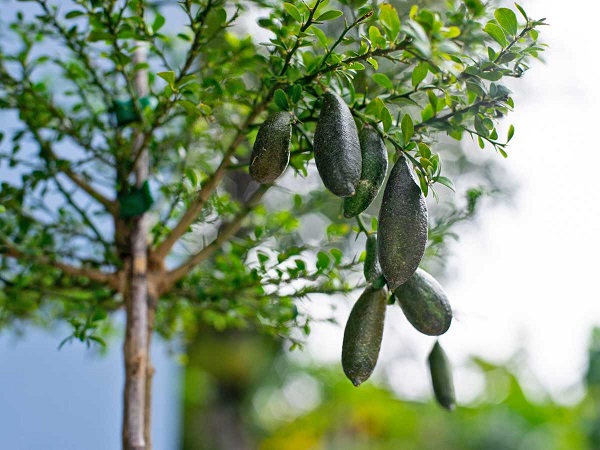
Citrus fruits have long been beloved for their tangy flavors and vibrant colors, gracing our tables and palates with their delightful presence. Among the diverse family of citrus, the finger lime plant (Citrus australasica) stands out as a truly remarkable and exotic member. With its distinctive appearance and caviar-like vesicles, the finger lime is gaining popularity among gardening enthusiasts and culinary adventurers alike. In this article, we will explore the captivating world of finger lime plants, from their origin and characteristics to expert tips on how to successfully grow and cultivate them in your own garden.
Origin and Characteristics: A Unique Citrus Marvel
The finger lime plant, also known as “citrus caviar” or “Australian finger lime,” is native to the rainforests of eastern Australia. This fascinating citrus variety was first discovered by Indigenous Australians and has been cultivated for generations for its culinary and medicinal uses. The finger lime plant is characterized by its slender, elongated fruits that closely resemble its namesake – fingers.
What truly sets the finger lime apart is the texture of its pulp. Instead of the typical citrus segments, finger limes contain tiny, pearl-like vesicles that resemble caviar. These vesicles burst with zesty juice when the fruit is gently squeezed, adding a burst of flavor and unique visual appeal to culinary creations.
Growing Finger Lime Plants: Step-by-Step Guide
Growing your own finger lime plant can be a rewarding and exciting experience. While it requires some specific care, the effort is well worth the exceptional citrus fruits you’ll eventually harvest. Follow these steps to successfully grow and cultivate finger lime plants:
Location and Climate
Finger lime plants thrive in warm, subtropical to tropical climates. They can also be grown in pots indoors in cooler regions. Choose a location with full sun to partial shade, ensuring the plant receives at least 6-8 hours of sunlight each day.
Soil Preparation
Finger lime plants prefer well-draining, slightly acidic to neutral soil. Amend the soil with compost or well-rotted organic matter before planting.
Planting
Plant finger lime seeds or grafted saplings in the prepared soil. If planting in a pot, ensure the container has good drainage and is large enough to accommodate the mature size of the plant.
Watering
Keep the soil consistently moist but not waterlogged. Finger lime plants do not tolerate soggy soil. Water regularly, especially during the growing season, and reduce watering in the dormant period.
Fertilization
Feed your finger lime plant with a balanced, slow-release citrus fertilizer during the growing season. Follow the manufacturer’s instructions for application rates.
Pruning
Prune the plant to promote bushy growth and maintain its shape. Remove any dead or diseased branches to ensure the plant’s health.
Pest and Disease Control
Keep an eye out for common citrus pests such as aphids, scale insects, and citrus leafminers. Use appropriate organic or chemical controls if necessary.
Harvesting
Finger limes typically start producing fruits within 3-4 years after planting. Harvest the finger limes when they are fully ripe, and the vesicles are plump and juicy. Gently cut the fruits from the tree to avoid damaging the plant.
Culinary Delights
Once harvested, the finger lime vesicles can be used to add a burst of flavor and texture to a wide range of dishes, from salads to desserts and beverages. By following these steps and providing your finger lime plant with the right care and attention, you can enjoy the unique and delectable fruits of your labor, adding a touch of exotic elegance to your garden and kitchen.
Embrace the Exotic Charm of Finger Lime Plants
The finger lime plant is a testament to the beauty and diversity of the citrus family. With its intriguing appearance, zesty flavor, and caviar-like vesicles, the finger lime offers a sensory adventure that is both visually captivating and tasty. By embracing the challenge of growing and cultivating finger lime plants, you not only unlock the secrets of this unique citrus gem but also embark on a journey of horticultural discovery that enriches your garden and elevates your culinary creations to new heights. So, set aside a special spot in your garden or patio, and let the enchanting world of finger lime plants inspire your green thumb and tickle your taste buds.
15 Fun Facts About Finger Lime Plants
Citrus Caviar
The finger lime’s nickname “citrus caviar” is well-deserved. Its vesicles, which contain the tangy juice, resemble tiny, glistening pearls of caviar, adding a burst of flavor and texture to culinary creations.
Ancient Origins
Finger lime plants have a long history, with evidence suggesting they have been cultivated by Indigenous Australians for thousands of years, making them a truly ancient fruit.
Colorful Array
Finger limes come in a variety of colors, ranging from green and yellow to pink, red, and even dark purple. Each color variation offers a slightly different flavor profile.
Botanical Oddity
Finger lime plants are hermaphroditic, meaning they have both male and female reproductive organs in each flower. This unique feature allows them to self-pollinate and produce fruits without the need for a separate pollinator.
Thorny Guardians
The branches of finger lime plants are often adorned with small thorns. These thorns not only protect the plant from herbivores but also help it climb and support itself as it grows.
Native Treasure
Indigenous Australians have valued finger limes for generations, using them for both culinary and medicinal purposes. The fruits were an important source of vitamin C and were also used as a natural remedy for various ailments.
Gourmet Appeal
Finger limes have gained popularity in upscale restaurants and gourmet cuisine for their unique appearance and flavor. They are often used as garnishes, in desserts, salads, seafood dishes, and cocktails.
Delicate Aroma
The aroma of finger limes is often described as a blend of citrus and floral notes, making them a sensory delight for those who experience their fragrance.
Plant Explorer’s Find
The finger lime plant was first formally described by botanist Frederick Manson Bailey in the late 1800s, but it remained relatively unknown outside of Australia until recent years.
Container Cultivation
Finger lime plants can be successfully grown in containers, making them suitable for urban gardens, patios, and even indoor spaces with adequate sunlight.
Zesty Burst
When the finger lime’s vesicles are gently squeezed or bitten, they release a burst of tangy juice that can range in flavor from sour to slightly sweet, depending on the variety and maturity of the fruit.
Drought Tolerance
Once established, finger lime plants are relatively drought-tolerant, making them suitable for regions with periodic water shortages.
Wild Relatives
The finger lime plant is closely related to other citrus fruits, such as lemons, limes, and oranges, but it possesses a distinct appearance and culinary appeal.
Limited Shelf Life
Finger limes have a relatively short shelf life once harvested, so they are best enjoyed soon after picking to experience their full flavor and texture.
Citrus Collection Gem
Finger lime plants make a unique addition to citrus collections, showcasing the incredible diversity within the citrus family.
Related Articles & Free Email Newsletter Sign Up
How to Create an Indoor Apartment Vegetable Garden
How to Grow Bananas in a Greenhouse



Comment here